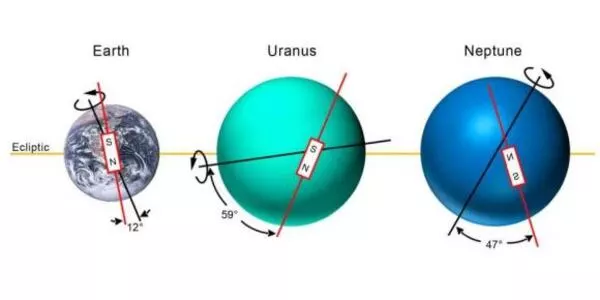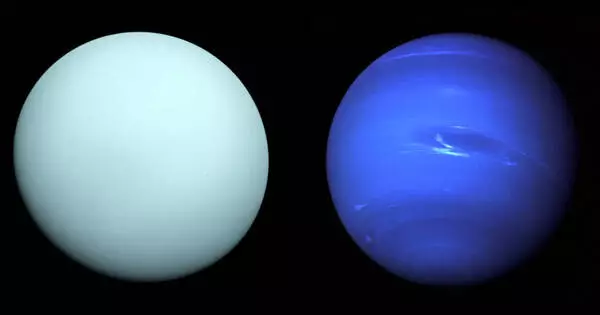Not all ice is created equal. Depending on the pressure and temperature conditions in the environment, the solid form of water can take on more than a dozen different crystalline structures. Superionic ice is a unique crystalline form that is half solid and half liquid and is electrically conductive. Its existence has been predicted using various models, and it has already been observed on several occasions under -extremely – laboratory conditions. However, the precise conditions under which superionic ices are stable are still debated.
A group of scientists led by Vitali Prakapenka of the University of Chicago and including Sergey Lobanov of the German Research Center for Geosciences GFZ Potsdam has now measured the structure and properties of two superionic ice phases (ice XVIII and ice XX). In a laser-heated diamond anvil cell, they subjected water to extremely high pressures and temperatures. The samples were also examined for structure and electrical conductivity at the same time. The findings were published in the journal Nature Physics today. They contribute another puzzle piece to the spectrum of water manifestations. They may also help to explain the unusual magnetic fields of the water-rich planets Uranus and Neptune.
Hot ice?
Ice is extremely cold. At the very least, type I ice from our freezer, snow, or a frozen lake. There are various types of ice, such as type VII or VIII, that exist at temperatures of several hundred or thousand degrees Celsius on planets or in laboratory high-pressure devices. This is due to extremely high pressures of several tens of gigapascals.
Pressure and temperature span the space for a substance’s so-called phase diagram: The various manifestations of water and the transitions between solid, gaseous, liquid, and hybrid states are recorded here based on these two parameters – as they are predicted theoretically or have already been proven in experiments.
Water is a relatively simple chemical compound made up of one oxygen atom and two hydrogen atoms. In the case of water, the fundamental physical and geoscientific interests come together because water plays an important role inside many planets. Not only in terms of life and landscape formation, but also, in the case of the gaseous planets Uranus and Neptune, in terms of the formation of their unusual planetary magnetic fields.
Sergey Lobanov
Linking fundamental physics with geological questions
The higher the pressure and temperature, the more difficult such experiments are. And so the phase diagram of water — with ice as its solid phase — still has quite a few inaccuracies and inconsistencies in the extreme ranges.
“Water is a relatively simple chemical compound made up of one oxygen atom and two hydrogen atoms. Nonetheless, because of its frequently unusual behavior, it is still not fully understood. In the case of water, the fundamental physical and geoscientific interests come together because water plays an important role inside many planets. Not only in terms of life and landscape formation, but also, in the case of the gaseous planets Uranus and Neptune, in terms of the formation of their unusual planetary magnetic fields” Sergey Lobanov, geophysicist at GFZ Potsdam, agrees.

Unique conditions in the lab
Sergey Lobanov is a member of the team led by first author Vitali Prakapenka of the University of Chicago, Nicholas Holtgrewe of the Carnegie Institution of Washington, and Alexander Goncharov of the Carnegie Institution of Washington. They have now refined the phase diagram of water at its extremes. They achieved high pressures of up to 150 Gigapascal (about 1.5 million times atmospheric pressure) and temperatures of up to 6,500 Kelvin by using laser-heated diamond anvil cells the size of a computer mouse (about 6,227 degrees Celsius). Conditions that occur at a depth of several thousand kilometers inside Uranus or Neptune then prevail in the sample chamber, which is only a few cubic millimetres in size.
The scientists used X-ray diffraction to observe how the crystal structure changes under these conditions. They carried out these experiments using the extremely bright synchrotron X-rays at the Advanced Photon Source (APS) of the Argonne National Laboratory at the University of Chicago. A second series of experiments at the Earth and Planets Laboratory of the Carnegie Institution of Washington used optical spectroscopy to determine the electronic conductivity.
Structural changes in ice as it passes through phase space: formation of superionic ice
The researchers began by creating ice VII or X from room temperature water by increasing the pressure to several tens of gigapascals. The temperature was then raised at constant pressure by heating it with laser light. They observed how the crystalline ice structure changed during the process: The oxygen and hydrogen atoms first moved slightly around their fixed positions. Only oxygen remained fixed, forming its own cubic crystal lattice. As the temperature increased, the hydrogen ionised, or lost its single electron to the oxygen lattice. The atomic nucleus of this solid, a positively charged proton, then whizzed through it, making it electrically conductive. In this way, a solid-liquid hybrid is formed: superionic ice.
Its existence was predicted on the basis of various models and has already been observed on several occasions under laboratory conditions. The scientists have now been able to synthesize and identify two superionic ice phases — ice XVIII and ice XX -, and to delineate the pressure and temperature conditions of their stability. “Due to their distinct density and increased optical conductivity, we assign the observed structures to the theoretically predicted superionic ice phases,” explains Lobanov.
Consequences for the explanation of the magnetic field of Uranus and Neptune
The phase transition to a conducting liquid, in particular, has intriguing implications for the unanswered questions surrounding the magnetic fields of Uranus and Neptune, which are thought to be composed of more than 60% water. Their magnetic field is unusual in that it is skewed and off-center, rather than running quasi parallel and symmetrically to the axis of rotation, as it does on Earth. Models of its formation therefore assume that it is created not by the motion of molten iron in the core, as it is on Earth, but by a conductive water-rich liquid in the outer third of Uranus or Neptune.
“The pressure and temperature in the interiors of Uranus and Neptune can be drawn in the phase diagram. In this case, the pressure can be used to approximate the depth inside. We can see from the refined phase boundaries that the upper third of both planets is liquid, but the deeper interiors contain solid superionic ices. This supports previous predictions about the origin of the observed magnetic field” Lobanov summarizes.





